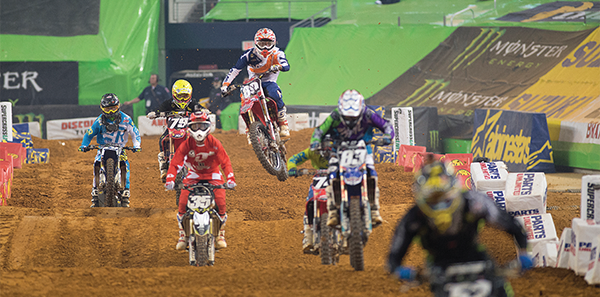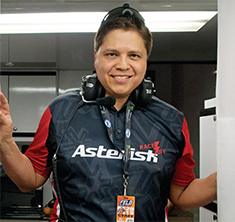
Few people would argue whether the specialty of emergency medicine has its own medical jargon that leaves most people scratching their heads. Occasionally, even our patients have been known to say (or ingest) things that may send us running to Google or Urban Dictionary. However, the emergency physicians who work in motorsports also have a language all their own.
Explore This Issue
ACEP Now: Vol 34 – No 10 – October 2015A typical exchange at a Supercross event:
Doc: “What happened?”
Rider: “Doc, I missed the holeshot. I had it pinned and was pushing through traffic. I was railing off of the berm trying to scrub that first triple when this squid whiskey throttled off of the face of that whoop, got squirrelly, and cased the second jump. I totally nailed him and endoed into the ruts. Got roosted on by about five dudes. I think I landed right on his foot peg.”
Doc: “So what hurts?”
Rider: “Everything!”
Doc: “Let’s get you checked out.”
Huh?!
Dirt bike racing is not in the realm of experience for most emergency docs, but for two emergency physicians, John Bodnar, MD, aka “Doc Bodnar,” and myself, Jim Kennedye, MD, MPH, FACEP, or simply “Doctor Jim,” it is second nature. Both of us are board-certified emergency physicians practicing full-time in EDs out of California and Oklahoma, respectively, and both have been riding and racing dirt bikes since the 1970s, when the sport of professional dirt bike racing, also known as “motocross,” exploded in popularity.

The Asterisk Mobile Medical Center travels across the country for the Monster Energy Supercross series and the AMA National Motocross series. The unit has four beds and the equipment needed to treat sick or injured riders and support staff. The AMMC has on board fluoroscopy, ultrasound, and cardiac monitoring/advanced cardiac life support equipment as well as supplies for managing fractures, lacerations, and various other medical issues. Routinely, injuries exceed the ability of the AMMC’s capabilities and patients are transferred to local hospitals fora higher level of care.
Dr. Kennedye checks a rider in the Asterisk Mobile Medical Center during the Monster Energy Supercross races in Arlington, Texas.
Dr. Kennedye, left, and Dr. Bodnar, right, check a rider in the AAMC.
Doc Bodnar is the founding member and serves as medical director of the Asterisk Mobile Medical Center (AMMC). A team of professionals staffs the AMMC and provides medical treatment and stabilization services for the athletes and crews of the Monster Energy Supercross series and the American Motorcyclist Association (AMA) Motocross Nationals across the United States. It is made up of a rotating crew of emergency nurses, orthopedic surgeons, physical therapists, and athletic trainers led by Doc Bodnar and head athletic trainer Eddie Casillas.
Motorsports 101
“Supercross” is the term for dirt bike racing at its highest level that occurs in major professional football and baseball stadiums across the country. The tracks of Supercross tend to be highly technical and shorter due to space constraints. “Motocross” tends to refer to longer outdoor tracks in more rural areas, which are less technical but come with the risks inherent with more riders and much higher speeds.
As you might expect, concussions, contusions, and various orthopedic trauma are commonplace during practice and racing sessions. –Dr. Kennedye
The racers at these events are professional athletes in every sense of the word, and top racers regularly demonstrate aerobic fitness on par with that of any athlete across all sports as measured by the VO2 max. Also, a top racer may have a six- to seven-figure income, and grounding them due to medical injury, a role assumed by the ED docs, is something never taken lightly. As you might expect, concussions, contusions, and various orthopedic trauma are commonplace during practice and racing sessions. However, riders and their crews are often on the road for 30 weeks or more out of the year and have all the typical non-racing-related ailments one might see in the ED on a typical day. If necessary, AMMC physicians are able to function as proxy primary physicians.

Dr. Kennedye keeps a very close eye on the action during the Monster Energy Supercross races. Dr. Kennedye stays on the track during the race to watch the riders and says a hard part of his job is watching out for the inherent dangers of being on the track. Dr. Kennedye keeps an eye on a rider on the back of the Asterisk Medical Mule as he and
Dr. Bodnar transport him off the track and back to the medical center for evaluation.
Most uninitiated people wonder how hard can it be just riding around a track. I’ve played most any sport you can think of, and riding motocross bikes on a track environment is the most aerobically demanding thing I’ve ever done bar none! Every muscle group is firing for 30 to 60 minutes at a time, and you’re constantly subject to forces many times the force of gravity while the bike is trying to throw you on your head. The skills of the pro riders are mind-boggling. Yet despite the speeds and heights attained by the racers, severe, life-threatening injuries are quite rare.
On the Course
During practice or race time, the emergency physicians and other members of the team position themselves trackside, keeping their “heads on a swivel,” monitoring for crashes and injuries while protecting their own safety. Coordination with the promoter and race officials is carried out via headset radio. If an accident occurs and the riders are unable to get up on their own and return to the action or to the pit area, Doc Bodnar and I have at our disposal several “medical mules,” which are converted four-wheel off-road vehicles. After stabilization and immobilization takes place trackside, they will transport the rider back to the AMMC, which is a large two-story 18-wheel rig that essentially functions as a mobile ED. It is equipped with ultrasound, fluoroscopy, slit lamp, and all of the necessary equipment for treatment of fractures, dislocations, and wounds.

Dr. Kennedye has been working on the medical staff for the Monster Energy Supercross and AMA National races since 2006. He spends a few weekends each race season traveling primarily the Midwest to be a part of the sport that he loves. Dr. Kennedye has been active in motocross since he was eight years old.
Doc Bodnar and I also organize local emergency medical services crews who are on scene to provide care and transport patients who require a higher level of care to the ED, if necessary. Between events, we provide post-concussion monitoring for the riders, helping guide them back safely to racing status. Additionally, we contribute to safety instruction for racers and provide constant feedback to racing equipment manufacturers that helps with innovation efforts. We’ve really become ingrained in the culture of professional motocross racing and have earned the respect of the riders, teams, and sanctioning bodies. It really helps to speak the language of medicine and motocross.
Why do we do it? Well, our skills set makes us uniquely qualified to coordinate the mission of the AMMC, and we enjoy the family environment of the teams. However, like all emergency physicians, we are adrenaline junkies and just love the sport. Once the love of riding gets in your blood, it’s hard to get it out. This allows us to fuse our love of medicine and motorcycles … plus, we’re terrible at golf.
Dr. Kennedye is a physician at St. Francis Hospital/EMP of Tulsa and serves on the Oklahoma Chapter ACEP Board and as an ACEP Councillor. He recently survived his first Sturgis Motorcycle Rally.
Pages: 1 2 3 | Multi-Page



No Responses to “Emergency Physicians Provide Medical Treatment in Supercross Stadiums”